In the Fall of 1977, Stephen King moved to England to write a ghost story. Much like the move to Colorado which resulted in The Shining and The Stand, he was looking for inspiration. “If I wrote about Maine all the time,” he said in an interview, “I’d go crazy.” New American Library duly sent out a press release which read, “With its history of eerie writers and its penchant for mystery, England should help Stephen King produce a novel even more bloodcurdling than his previous ones…” And it did. The book was called Cujo but it wasn’t about ghosts, it was about a rabid dog. It was a thriller so experimental that not many writers would try it today. And it wasn’t set in England at all. It was set in Maine, in the summer, during a heat wave.
King’s writing suffered in England, and so did his family. He felt flat, cut-off, and uninspired. Their rented house was damp, no one could get warm, and after just three months they cut their year-long stay short and returned home. But while in the UK, King read an article about a kid in Portland, Maine who was killed by a Saint Bernard, which clicked into place with an incident from the previous year in which he’d taken his motorcycle out to the middle of nowhere to get fixed. He managed to get his bike into the driveway of the mechanic’s house before it died. From across the road he heard growling and turned to see a massive Saint Bernard approaching, ready to attack. The dog only stood down when the mechanic strolled out of his barn and smacked it on the haunches with a socket wrench, saying, “Joe must not like you.”
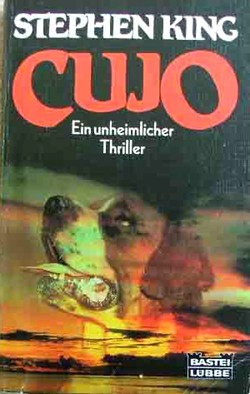 Then King started thinking about the banged up Pinto he and his wife had bought with their $2500 Doubleday advance for Carrie. They were still driving it in the late 70’s, and the car had a sticky needle valve on the carburetor, which meant it kept stalling. King started to wonder, what if the Pinto acted up and his wife was the one who drove it to the mechanic’s in the middle of nowhere? What if she had one of their kids with her? And what if there was no one around to whack the Saint Bernard on the butt with a socket wrench? Even worse, what if the dog were rabid?
Then King started thinking about the banged up Pinto he and his wife had bought with their $2500 Doubleday advance for Carrie. They were still driving it in the late 70’s, and the car had a sticky needle valve on the carburetor, which meant it kept stalling. King started to wonder, what if the Pinto acted up and his wife was the one who drove it to the mechanic’s in the middle of nowhere? What if she had one of their kids with her? And what if there was no one around to whack the Saint Bernard on the butt with a socket wrench? Even worse, what if the dog were rabid?
Briefly, King toyed with the idea that the mother would get bitten, infected with rabies, and have to fight to keep herself from attacking her son, but around page seventy he discovered that the gestation period for rabies was too long for this idea to work. Nevertheless, he was on fire, and before he knew it he’d churned out the first hundred pages of his new book. Which is mostly famous these days as “the drunk book.”
In King’s On Writing he immortalizes Cujo with, “At the end of my adventures I was drinking a case of sixteen-ounce tallboys a night, and there’s one novel, Cujo, that I barely remember writing at all…I like that book. I wish I could remember enjoying the good parts as I put them down on the page.” For those who are counting, that’s three gallons of beer a day. What writers drink is often more famous than what they write and this comment has overshadowed Cujo’s virtues, probably forever, which is too bad.
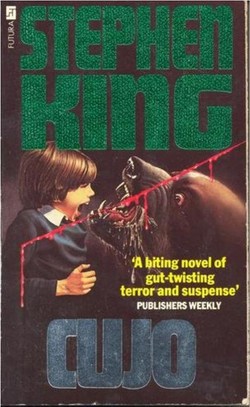 One hundred pages shorter than The Dead Zone, Firestarter, and Pet Sematary (two hundred pages shorter than Christine) there’s a lot packed into its lean frame. Everyone remembers the broad outline—woman and kid get trapped in their stalled car by a rabid Saint Bernard—but actually re-reading it reveals a very strange struture. Lots of suspense novels have two, or even three, storylines running on parallel tracks, and eventually they all converge. Cujo has three storylines, three separate sets of characters, and none of them have much to do with each other at all.
One hundred pages shorter than The Dead Zone, Firestarter, and Pet Sematary (two hundred pages shorter than Christine) there’s a lot packed into its lean frame. Everyone remembers the broad outline—woman and kid get trapped in their stalled car by a rabid Saint Bernard—but actually re-reading it reveals a very strange struture. Lots of suspense novels have two, or even three, storylines running on parallel tracks, and eventually they all converge. Cujo has three storylines, three separate sets of characters, and none of them have much to do with each other at all.
Taking centerstage is Donna Trenton and her four-year-old son Tad, who drive out to Joe Camber’s house in the sticks to get their Pinto’s faulty needle valve replaced. They arrive at the garage on page 145 (out of 300) so by the time the Pinto jerks to a stop in the driveway we know Donna pretty well. Self-involved, not too smart, she’s passive in a crisis and her entire relationship with Tad consists of apologizing to him after she’s lost her temper. She isn’t a bad person, but you sense her limitations. You want her to be different—stronger, more passionate, patient—but you understand why she isn’t. She is who she is.
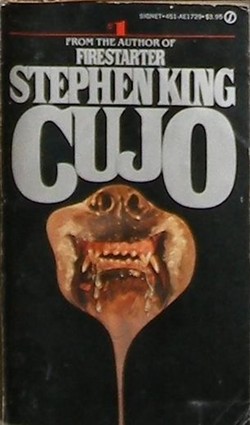 Tad, on the other hand, is a tantrum-throwing kid who’s scared of his own shadow. But in a long description of a repetitive parking game he plays with his trucks King reveals that this outwardly pointless activity is, for Tad, a vital coping mechanism because he’s all-too-aware of the unrest in his parents’s marriage. It’s a nice insight from King, who, if he has become anything, has become a great depictor of the inner lives of children. And so, as Donna and Tad march grimly into Cujo’s maw, the reader is all-too-aware of their numerous flaws. The little Pinto will become a crucible that cooks away their impurities, transforming Donna into a proactive warrior too late to save anyone but herself.
Tad, on the other hand, is a tantrum-throwing kid who’s scared of his own shadow. But in a long description of a repetitive parking game he plays with his trucks King reveals that this outwardly pointless activity is, for Tad, a vital coping mechanism because he’s all-too-aware of the unrest in his parents’s marriage. It’s a nice insight from King, who, if he has become anything, has become a great depictor of the inner lives of children. And so, as Donna and Tad march grimly into Cujo’s maw, the reader is all-too-aware of their numerous flaws. The little Pinto will become a crucible that cooks away their impurities, transforming Donna into a proactive warrior too late to save anyone but herself.
Plotline number two tells the story of Donna’s husband, Vic, whose tiny advertising company is losing its biggest client thanks to a breakfast cereal made with an untested red dye that turns the vomit and feces of those who ate it a shocking scarlet. Vic’s ad agency becomes the scapegoat in the ensuing PR disaster and he and Roger, his partner, have to fly to New York to try to save everything they’ve built from going under. The night before Vic leaves he discovers that Donna has been having an affair with the local tennis pro. When she broke it off the vindictive lothario sent an anonymous letter to Vic, who confronts Donna and she, in a scene King says he dreaded writing, confesses everything: her frustration, her boredom, and her fear of getting old. The two agree to try to make things work, but Vic’s not so sure.
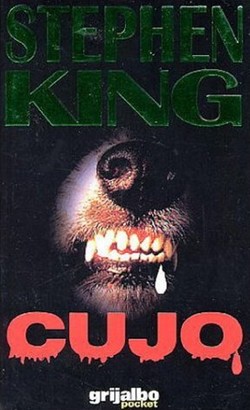 The third plotline involves Joe Camber himself, the owner of Cujo and the garage where Donna and her Pinto have a date with destiny. Camber is a nasty redneck who whips his wife with a belt and has no bigger dreams than heading to Boston for a weekend of hookers, hootch, and baseball. He’s got a nice touch with an engine, but that’s his only redeeming quality. Even saying that this is his storyline does it a disservice because it really belongs to Charity, his wife. Penny-pinching, pious, prim, and judgmental, she would normally be one of King’s evil Christians but here he gets inside her skin and she becomes the most compelling character, after Cujo, of course.
The third plotline involves Joe Camber himself, the owner of Cujo and the garage where Donna and her Pinto have a date with destiny. Camber is a nasty redneck who whips his wife with a belt and has no bigger dreams than heading to Boston for a weekend of hookers, hootch, and baseball. He’s got a nice touch with an engine, but that’s his only redeeming quality. Even saying that this is his storyline does it a disservice because it really belongs to Charity, his wife. Penny-pinching, pious, prim, and judgmental, she would normally be one of King’s evil Christians but here he gets inside her skin and she becomes the most compelling character, after Cujo, of course.
Charity wants a better life for her ten-year-old son, Brett, and her marriage with Joe is a secret war for Brett’s soul. Joe wants Brett to follow in his footsteps and inherit the land, the house, his automotive business, and his prejudices. Charity realizes that Brett has a chance to be someone better but he needs to be exposed to a different way of life before it’s too late. When she wins $5,000 in the state lottery she negotiates a trip to visit her estranged upper middle class sister with Brett, hoping that he’ll see that there are other ways to live, but there are already disturbing signs that she may be too late.
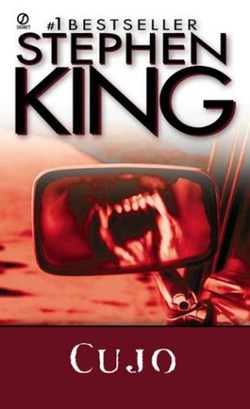 There’s nothing new about these three plotlines existing, but what’s audacious is King’s cross-cutting. At a moment of maximum tension in the Pinto, as it looks like Tad might die of dehydration, King cuts to a scene of Charity and Brett eating lunch with Charity’s sister, or he shows us Vic and Roger brainstorming an idea for an ad campaign that might save their company. Also different is that the three strands don’t overlap. There is some tension to be found in whether Vic will realize what’s happening and race to Donna’s rescue, but Charity and Brett’s story has no impact on what’s going on back on the farm.
There’s nothing new about these three plotlines existing, but what’s audacious is King’s cross-cutting. At a moment of maximum tension in the Pinto, as it looks like Tad might die of dehydration, King cuts to a scene of Charity and Brett eating lunch with Charity’s sister, or he shows us Vic and Roger brainstorming an idea for an ad campaign that might save their company. Also different is that the three strands don’t overlap. There is some tension to be found in whether Vic will realize what’s happening and race to Donna’s rescue, but Charity and Brett’s story has no impact on what’s going on back on the farm.
Oddly enough, the other two plotlines are almost more compelling than Donna and Tad’s, even though no one else is in any physical danger. Maybe it’s because Charity and Vic are proactive where Donna is passive, strong where she is weak. All three characters are facing overwhelming odds but Donna has no desires beyond living another day with her world unchanged. Vic and Charity both want to change their circumstances and they set out to do so in smart, unexpected ways.
Donna’s entire ordeal in the car consists of getting trapped, trying to escape once, getting bitten in the attempt, and then spending most of the rest of the book in a restless doze in the front seat, nursing her wounds and trying to keep Tad’s spirits up. But it’s Charity’s crisis over whether to divorce Joe and stay with her sister, never exposing her son to Joe’s toxic personality again, that is truly gripping. It’s Vic’s struggle in the face of overwhelming odds to save his company that has you on the edge of your seat.
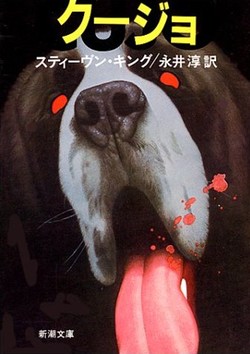 King originally wrote Cujo in chapters, but he wanted the book to feel like “a brick thrown through somebody’s window, like a really invasive piece of work. It feels anarchic, like a punk-rock record,” and so he stripped them all out. The result is a book where the words flow in an unbroken stream, turning into a way to physically pace the reading experience. Donna and Tad’s story, far from being action packed, mostly consists of the two of them sitting in the front seat of their car, crying, so what we get are long internal monologues from Donna. Her sections of the book become more and more skimmable as long paragraphs of text unravel in her mind, but these chunks start to act as a fast forward button, because you begin to skim them, waiting for something—anything—to happen. You flip through her sections faster and faster, the release of tension so delayed that you begin to physically ache for it. When the sequences of Cujo attacking appear they seem to unfold in slow motion, as your reading speed drops from skimming paragraphs to savoring every sentence. It’s a filmic technique and one that I have to believe King used consciously.
King originally wrote Cujo in chapters, but he wanted the book to feel like “a brick thrown through somebody’s window, like a really invasive piece of work. It feels anarchic, like a punk-rock record,” and so he stripped them all out. The result is a book where the words flow in an unbroken stream, turning into a way to physically pace the reading experience. Donna and Tad’s story, far from being action packed, mostly consists of the two of them sitting in the front seat of their car, crying, so what we get are long internal monologues from Donna. Her sections of the book become more and more skimmable as long paragraphs of text unravel in her mind, but these chunks start to act as a fast forward button, because you begin to skim them, waiting for something—anything—to happen. You flip through her sections faster and faster, the release of tension so delayed that you begin to physically ache for it. When the sequences of Cujo attacking appear they seem to unfold in slow motion, as your reading speed drops from skimming paragraphs to savoring every sentence. It’s a filmic technique and one that I have to believe King used consciously.
Cujo himself becomes the book’s tragic hero. King had attempted to write from a dog’s point of view before (Kojack in The Stand) but he outdoes himself here. Cujo is a good dog who can’t help but go bad once the rabies virus gets into his blood, and that sense of random helplessness infects the entire book. Effort isn’t rewarded, instead rewards come randomly. Donna takes action and kills Cujo but too late to save Tad, who dies (something King said he didn’t know would happen until he was typing those pages). Vic and Roger find their company is saved, but not by their big idea. The cereal company has a last minute change of heart and stays with them as the result of an internal power struggle. And Brett does get saved, but not by Charity’s efforts. Instead, Joe is killed by Cujo taking the decision entirely out of her hands.
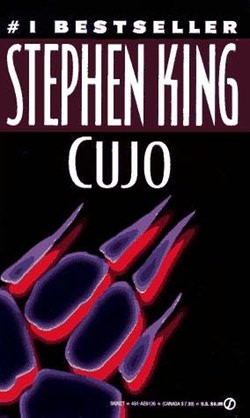 That’s the surprise of Cujo. It’s not a simple thriller, but a book that feels like it accurately traces the vast, interconnected web of life, how all of us, from the drunk on the corner, to the cop on the beat, to the dog in our yard are connected to one another, and how a small decision here can yield great consequences over there. The book moves with the gentle rhythms of real life, long moments of stasis broken up by bursts of decisive action. And it has a non-judgmental acceptance of what happens, and an emphasis that no matter what—rabies, dead child, adultery, bankruptcy, lottery—life goes on.
That’s the surprise of Cujo. It’s not a simple thriller, but a book that feels like it accurately traces the vast, interconnected web of life, how all of us, from the drunk on the corner, to the cop on the beat, to the dog in our yard are connected to one another, and how a small decision here can yield great consequences over there. The book moves with the gentle rhythms of real life, long moments of stasis broken up by bursts of decisive action. And it has a non-judgmental acceptance of what happens, and an emphasis that no matter what—rabies, dead child, adultery, bankruptcy, lottery—life goes on.
In Cujo, one boy dies, but another boy gets a chance to have a life. Victories are qualified, there are no guarantees of a happy ending, and a good dog dies turning on the people it loved. Deeply immersed in the minutae of rural life in Maine, and with ambitions that sprawl far beyond the scope of genre requirements, Cujo takes its place next to novels like Thomas Harris’s Red Dragon as a thriller that’s written at a level you don’t often find. And considering that its main character gets the least amount of page time, it’s only appropriate to let Cujo himself have the last word:
It would perhaps not be amiss to point out that he had always tried to be a good dog. He had tried to do all the things his MAN and his WOMAN, and most of all his BOY, had asked or expected of him. He would have died for them, if that had been required. He had never wanted to kill anybody. He had been struck by something, possibly destiny, or fate, or only a degenerative nerve disease called rabies. Free will was not a factor.
A small (for King), strange, melancholy book, Cujo makes it plain that King’s ambitions at this point went far beyond merely scaring his audience.
Grady Hendrix has written about pop culture for magazines ranging from Playboy to World Literature Today. He also writes books! You can follow every little move he makes over at his blog.










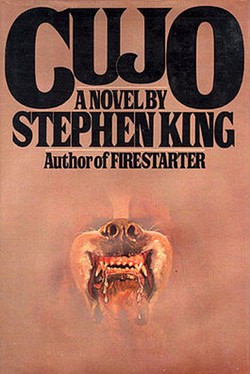
First King book I read. I was maybe nine. Utterly terrified me.
I read Cujo quickly during a camping trip when I was a teenager and I remember not actually liking it much. The plot line with the cereal did absolutely nothing for me and its only purpose in the book seemed to be to have Donna’s husband gone when she needed him. It was an awfully big build-up for nothing. The affair plot also didn’t do anything for me. I had, until today, totally forgotten about the Charity/Brett plotline. Somehow, I even managed to forget that Tad died in the book. I was also really annoyed that the book couldn’t seem to decide if Cujo went bad because he had rabies, or was possessed or if his rabies led to his possession and that led to him turning evil.
On the other hand, I do remember that the scenes from Cujo’s point of view were excellent and I really felt bad for him. It made the scenes at the end when Donna finally takes him on with the baseball bat all the worse, because I liked that poor dog.
All-in-all, I think this short book would have been better if it were even shorter. Strip it down to novella length (like one of the stories in Four Past Midnight) and I probably would have like it a lot more.
I had read this after watching the movie, and that made it creepier. I liked the scenes with Donna, Tad, and Cujo more than anything.
King’s drinking and drug use making him forget writing this book is a good reason why writers should not be doing those things. That’s the path I’m taking at least by drinking nothing stronger than a straight, strong black tea. I do understand that him taking those things helped him understand better the effects of them, but look what it did to him, he nearly died from over using them and then made it worse by going cold turkey, giving us Hearts in Atlantis and The Girl who Loved Tom Gordon. If he had gradually stopped taking them his writing wouldn’t have gone soft like that. At least he’s getting to a middle ground since I loved Under the Dome.
@2 I totally forgot about the possession/ghost angle till you mentioned it. It sure didn’t contribute anything (other than the idea that you should go read The Dead Zone), but it was so extraneous that it didn’t hurt the rest of book for me– I mean, I didn’t see it as “King can’t decide if there’s a ghost or not” so much as King had a pointless idea about a ghost early on which he totally dropped, and then later on he thought it’d be cool to bring it up during the death scene of the character he borrowed from The Dead Zone. Considering the state he was in when he wrote it, I’m amazed that the rest of the book isn’t full of total non-starter things like that.
If you only read it as a teenager, and were so not into it that you forgot Tad died, it’s worth a reread – pretty much everything Grady mentions here is stuff that just isn’t ever going to be interesting to a kid.
“Nope, nothing wrong here” still cracks me up. Ill always love the cereal professor storyline.
I forgot about the Charity and Brett storyline too and still don’t remember them, might be re-read time. (Except I read this originally when I didn’t have kids and books where bad things happen to kids are harder to read now.)
i
Why didn’t she just get the tire jack out of her car’s back? Or even the tire itself.